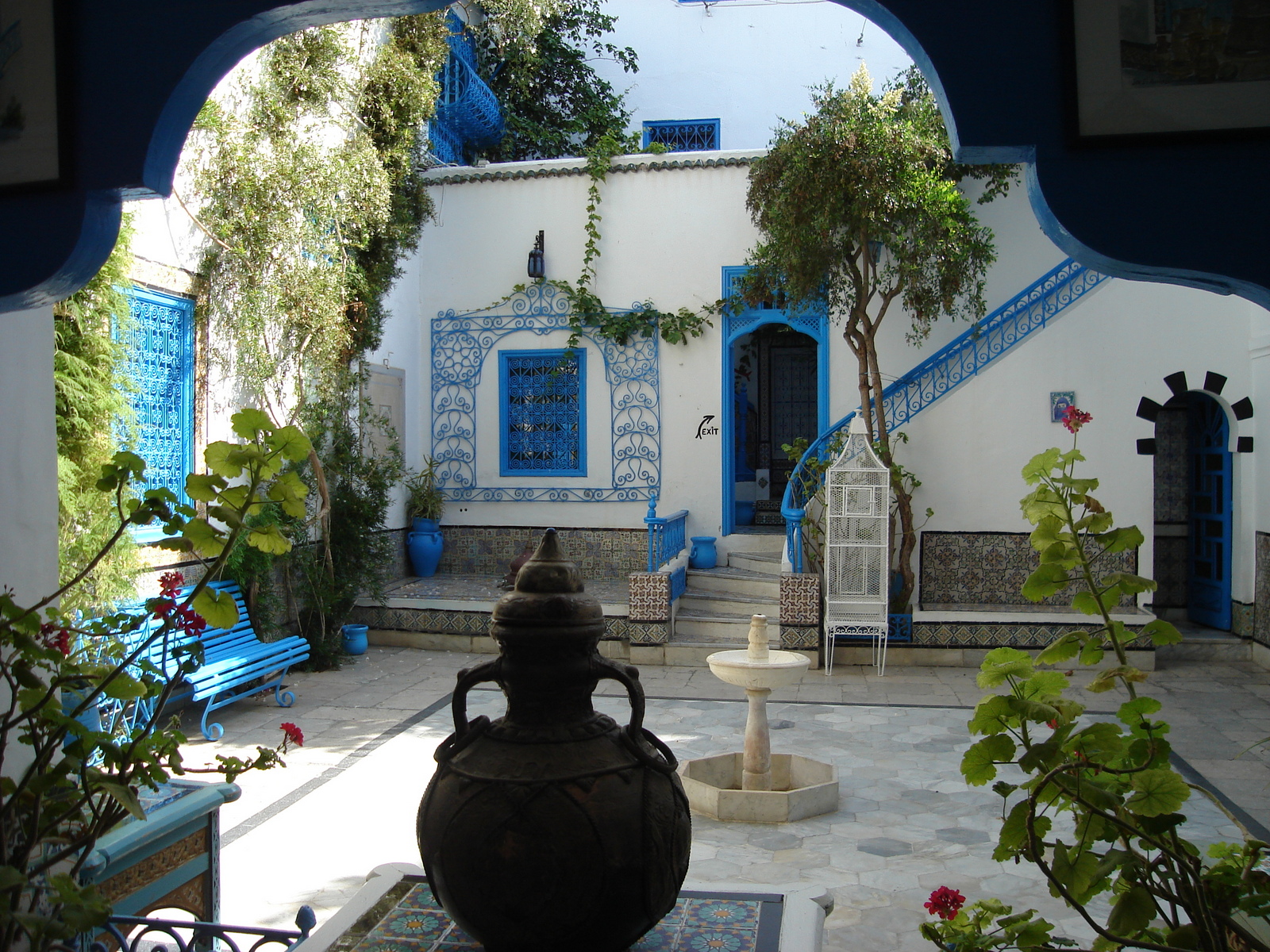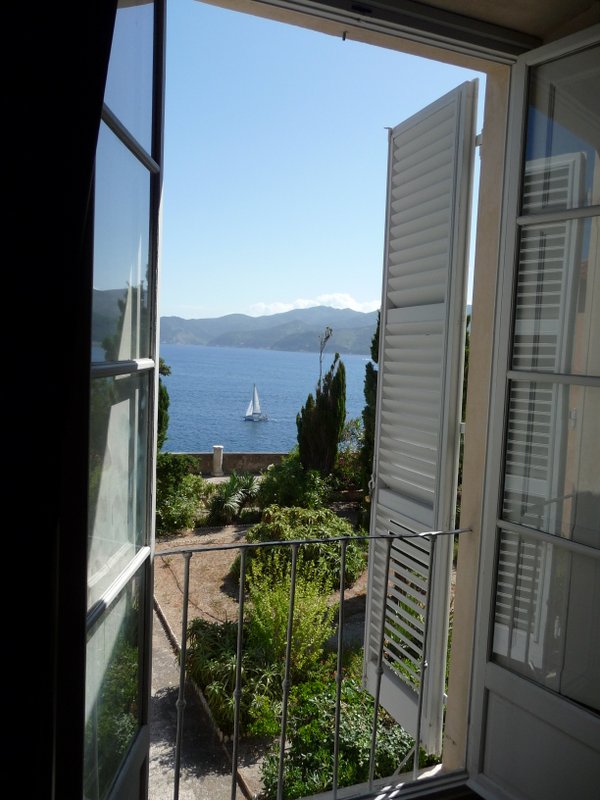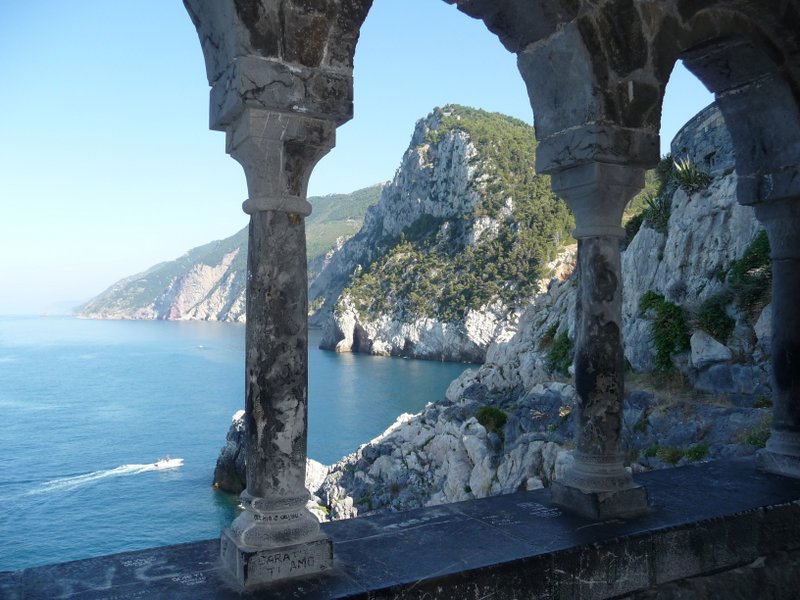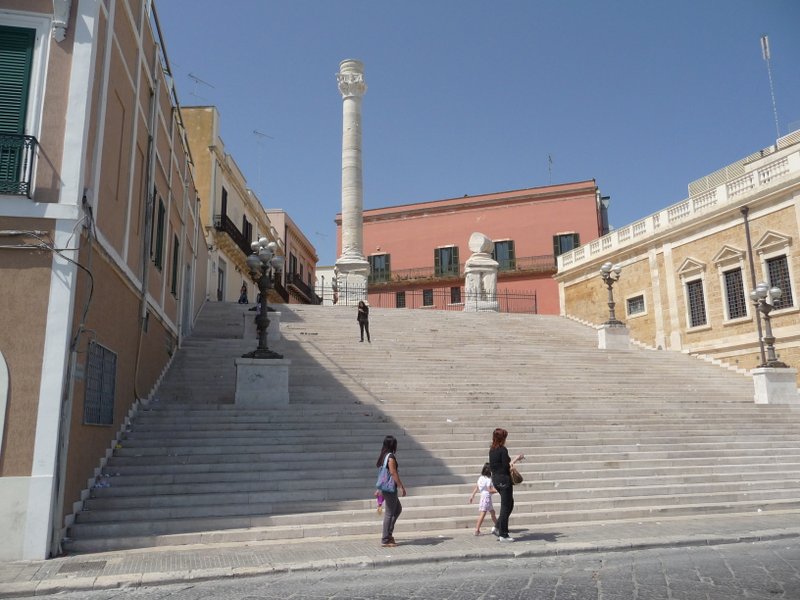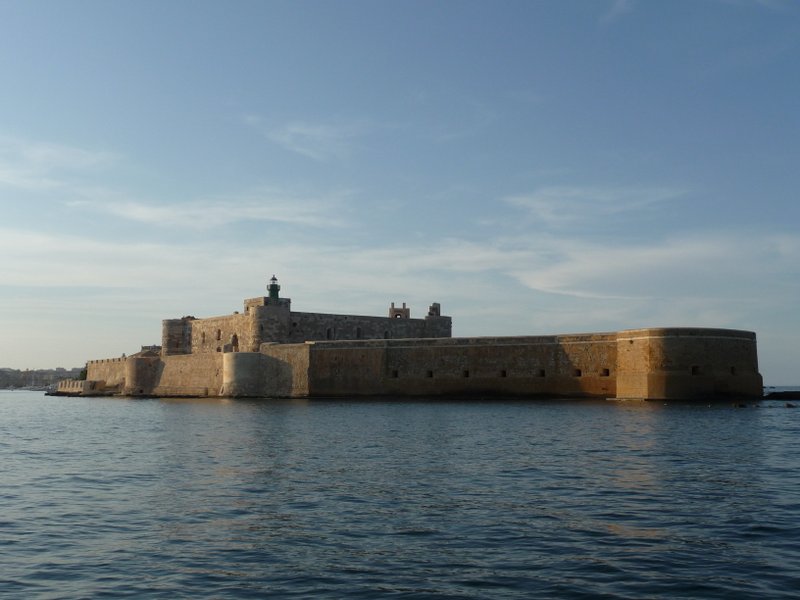The south coast of Italy between Salerno and Reggio Calabria offers some great cruising for visiting yachts. Most local boats skip this area when heading between the Aeolian Islands or Sicily and Naples. The noticeable lack of tourism in the area means that the towns are friendlier, the people curious and overall it is less expensive than the Italian hot spots further north and south.
We arrived back on mainland Italy at the small town of Vibo Valentia and went into one of the two small marinas adjacent to the town. The Marina Stella del Sud is a very convivial little place run by a Canadian-Italian family and caters mostly to local power boaters. The first step off the floating pontoon is into a little café/bar where we saw replete with a book exchange! Taking advantage of a rare visit to a marina, we spent two long days scrubbing, washing, shopping and making an attempt to catch up on the inexhaustible task of maintenance.
Vibo Valentia is a quiet but very friendly little town that doesn’t appear on most tourists’ radar screen. Everyone we came in contact with-marina staff, butcher, cell phone agent, grocer-was very warm and helpful. After a major provisioning run, the local SISA supermarket even delivered our purchases (and us) right down to the boat-a huge bonus when shopping at a supermarket that is a mile’s walk from the marina and taxis are non-existent. We had a sumptuous seafood dinner out at a family-run trattoria called Maria Rosa and the next evening, to-die-for pizzas at a place called Sapori di Mare. Both restaurants had excellent service, good wines and very reasonable prices.
On our last day at Vibo Valentia, we cast off the lines from the marina and anchored in a calm area just outside the breakwater. With clear water and no traffic, this seemed like a good spot to give Moonshadow’s bottom a much-needed cleaning. We dropped into the water with brushes in hand and began to “mow the lawn,” only to be accosted soon after by giant jellyfish. After repelling four advances, Merima had enough and got out of the water. I took a direct hit on my right leg but carried on cleaning, encouraged only by the fact that the sting was not too painful. These jellyfish, an impotent cousin to the Portuguese man-o-war and about a foot across, seemed to sense where we were and just kept charging like a bull towards a red cape. I had to keep a constant eye out for them and kicked a few away with my fins while I was wiping, making an already unpleasant task nearly unbearable. After a tank and a half of air, the job was finished and Moonshadow had a nice clean bum.
The next morning we headed north, finding a calm overnight anchorage outside the breakwater at the port of Cetraro. From there, the coastline becomes much more dramatic and beautiful, with steep mountains plunging into the sea. We pulled into the rather snug harbor of the quaint fishing village of Maratea hoping to find space on the town quay. There was little space to tie up and even less in which we could maneuver. Merima rang the Porto Turistico and we were quoted €90 for tie up in the marina, but for that night only. The next day was the beginning of “high season” (July 1) and the rate would jump to €120. We gave it a miss and went around the point and anchored in a nice little bay where we had lunch and took in the scenery. Maratea is a very picturesque village nestled in the base of a gorge. On the highest peak overlooking the area is a large statue of the Christ with outstretched arms, much like the one in Rio de Janeiro.
It was at Maratea that we noticed the first of a network of watch towers built in ancient times, apparently to guard the coast. These towers, usually about five to seven stories high and constructed of stone, stand on each promontory in direct line of sight of the next ones up and down the coast. Some are in ruin, while others remain reasonably intact. A few we saw had become the foundations for lovely elevated villas. We would see these every half mile or so all the way to the end of the Amalfi Coast near the Isle of Capri.
After our lunch below a watchtower villa, we carried on to the town of Sapri and anchored in a large and well-protected bay off the town’s beach. Sapri is a lovely little town where farm meets beach, and like Vibo, is friendly and relatively untouched by tourism. We decided we would stop there and chill out for a few days. In town we found an old fashioned ferramento (hardware store) with floor to ceiling shelves neatly stocked with a plethora of bits and pieces for home and boat. We managed to find a few things on our “to get” list. After, we wandered the narrow streets and were guided by a lovely old lady to the piazza (town center), where we found an excellent supermarket and panetteria (bread shop). While it is often imitated in other parts of the world, there is absolutely nothing like fresh-baked Italian bread.
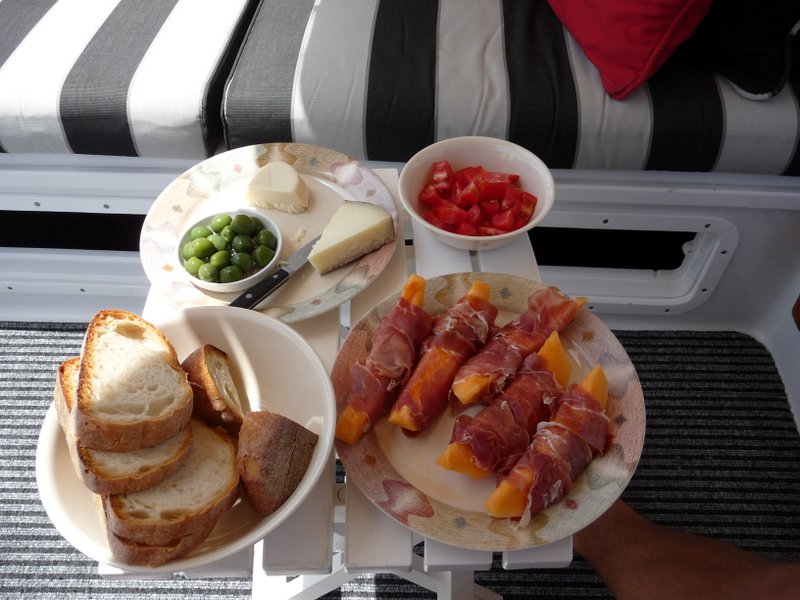
A casual Italian style lunch on board
I had a last go at repairing our number two outboard, a small 3hp job that had been running intermittently since last season, with no joy. Noticing a Yamaha shop just a few meters from our dinghy landing spot, I finally capitulated and took it in for professional repair. In dealing with the shop owner, Merima added a few more words to her vast Italian vocabulary such as candela (spark plug), scintilla (spark), tasto (kill button) and carburatore (carburetor) while translating for me. It was a successful venture and now our back-up outboard is once again running like a top.
Our next stop was a lovely little fishing village called Scario. We were able to take reasonably protected anchorage outside of the marina and found a good dinghy landing on the beach outside the breakwater. We wandered along the waterfront and back streets of the village admiring the lovely old stone buildings and found an exceptional grocery store where we picked up a few provisions. On the way back to the boat, Merima came upon a hairdresser that could accommodate her on the spot for a haircut. She and Gerardo the hairdresser, who was an Italian version of Richard Simmons became fast friends. When I picked her up an hour later, her face had a funny orange cast with a heavy application of green eyeliner and bright pink lipstick. Thinking she was a victim of a toxic chemical spill but not wanting to embarrass her in the salon, I waited till we were outside and asked Merima what happened to her face. With an embarrassed look, she told me Gerardo also fancied himself as a make-up artist, and insisted on giving her the full treatment before letting her leave the salon. Needless to say I was not allowed to take photos. Gerardo also recommended to us an excellent trattoria for dinner and invited us to stay with him if we ever returned to Scario without the boat.

The friendly little village of Scario
That afternoon we experienced something that we hadn’t encountered for the past two and a half seasons-a gully washer of a thunderstorm. The boat got a great wash down and we managed to catch enough fresh water to fill the tanks. Of course we tried out the trattoria Gerardo had recommended and had a delicious dinner that evening.
We continued north the next morning and found an excellent anchorage on the south side of Capo Palinuro. This was a very popular spot with the locals and there were dozens of boats there by the time we arrived, enjoying a sunny Saturday afternoon. By sunset all but a few were gone, no doubt back to the safety and security of their marina. The boats were replaced with a large flock of very rowdy seagulls. For awhile we were afraid they were rehearsing for a sequel to “The Birds.” It was July 4th, so we celebrated American Independence Day in style by
by grilling steaks and corn on the barbeque.

Fourth of July barbeque
We arrived the next day in the little town of Acciaroli and anchored in the lee of the harbor mole. It was a Sunday and town was bustling. Sun worshippers were on the beach and those with boats were heading out for a more private tanning session. We decided to relax aboard for the afternoon and go into town the next morning. We were lucky that Monday is market day in Acciaroli and the merchants had their stalls set up on the town quay. We picked up a few fresh provisions and enjoyed perusing all the food and wares on offer. The town seems to be in the process of waking up to tourism and is getting a significant dose of gentrification. Along the main pedestrian-only street is an assortment of shops, cafes and a couple of rather trendy-looking upscale restaurants. We stopped for an espresso and some people watching. The anchorage became a bit rolly in the afternoon so we headed out in search of better protection.

Purple is popular in Acciaroli
Up the coast about 5nm we found good anchorage at Oligastro in between two very crowded mooring areas chock-full of small local boats. An all-inclusive resort on the beach was crowded with holidaymakers and loud music blared from the speakers as they conducted aerobics classes and mambo lessons. Fortunately it all quieted down in the evening and we had a peaceful night under a full moon.

Enjoying the sun aboard a traditional boat, Oligastro

Full moon over the bay, Oligastro
We took a long hitch north the next day across the Golfo di Salerno to the legendary town of Amalfi. With its magnificent villas, verdant terraced gardens, spectacular cathedrals and colorful village homes clinging to the precipitous mountainside, Amalfi is arguably one of the most picturesque seaside towns in Italy. By then it was high season and the town was buzzing with hoards of tourists. The beach was paved with people staked out under row after row of colorful umbrellas who had paid for the privilege. Boats of all types and sizes from gigayachts to small dinghys were out on the water seeing and being seen, whipping the cove up into an unwieldy slop. We bobbed around on the anchor for a few hours before we decided to find some place a bit more peaceful.

Amalfi
A few miles up the coast towards Salerno sits the village of Cetara. Not as picturesque as Amalfi, but certainly attractive, Cetara has a small harbor and we were able to anchor and get some protection from the swell and wakes refracting along the Amalfi Coast. Cetara is in a “hurricane gap” so the afternoon breeze came down from the mountains at 20+ knots. It must be a regular occurrence, as a swarm of windsurfers rocked up to take advantage of the strong breeze and flat water, making high speed reaches back and forth in front of the harbor and village and getting some pretty good air off of the waves. We went in and had stroll around the quaint little town the following morning and found some nice little shops selling veggies and other foods. What was once a quiet and forgotten little fishing village was now just another tourist hot spot along the famous Amalfi Coast.

Cetara with its ancient watchtower on the right
Later in the day we headed a few more miles west to the city of Salerno and took anchorage in the large open bay between the two ports. Protection is not good from the south and west but we put on the flopper stopper and were reasonably comfortable. We didn’t have much joy calling the marinas on the cell phone, so we took the dinghy in to visit them all one by one. Finally, the last place we tried had space. The capo or boss of the marina was a very warm and friendly man and enjoyed conversing with Merima about our travels on Moonshadow. She was able to negotiate a couple of days in the marina at a 20% discount, although it was still expensive. We shifted into the marina the next morning and had a wash and cleanup day, and then went into town to have a look around and get a few provisions. The capo recommended an excellent restaurant near the port where we had a great pizza dinner.
It seems that Italy has embraced recycling in a big way. We have seen separate bins for recyclable rubbish in many places we have visited. On the quay at the marina, they had bins for glass, paper, aluminum, plastic, organic and inorganic waste. What they didn’t have was an everything bin. While we have pretty good space on board, we don’t have facilities for separating six types of rubbish. We had to carry our sack all the way into town to find a good old fashioned pre-rubbish-apartheid dumpster.
Salerno is a big town, busy, covered in graffiti and crowded with too many Singapore-type, non-descript apartment blocks. Despite this we found the people very friendly and helpful and the old quarter near the port was quaint. The pedestrian-only shopping street, Corso Vittorio Emanuele II, was lined with upscale shops and cafes and crowded with fashionable shoppers.
Our Auckland sailing friend Cecele arrived by train the next evening. A pickpocket had pinched her cash and credit cards while she was in the queue for train tickets in Rome, so after a day filled with drama, she was ready for a glass of wine (or three) and a meal. We headed straight into the old quarter to a traditional trattoria recommended by the marina capo. Once again, he was spot-on and we had a wonderful meal which included a veal involtini, pasta con faggiole, pizza and a few other tasty dishes, washed down with some excellent local Calabrian wine.
During our stay in Salerno we were never able to pass the capo’s office without him stopping us and embracing us for at least five or ten minutes of friendly conversation. Before we left he insisted on coming down to the boat and giving us a warm arrivederci (goodbye).
We tossed off the lines and with hardly a breath of breeze cruised along the spectacular Amalfi Coast passing by Cetara and Amalfi and anchoring at the gorgeous village of Positano. By the time we got to Positano there was a pretty good swell running. Sitting on an open bay, Positano has no harbor or marina, and a beach landing was a bit dangerous. After a couple hours of taking in the spectacle of megayachts, flash speedboats, sun worshippers and the stunning coastal landscape, we moved on hoping to find better protection from the swell.
We headed a short distance to the Galli Islands, a small cluster of privately owned islands, and anchored in deep water behind an islet that was capped with an old lighthouse and a couple of spectacular villas. It was reasonably comfortable but a fresh northerly breeze developed and blew at 20+ knots well into the evening. When it finally died down it left a large and rather confused sea, bouncing Moonshadow around and ruining any hopes that the crew had of a good night’s sleep.
The next morning we continued westward past the end of the Amalfi Coast and out to the celebrated Isle of Capri. Capri is more or less a large hunk of rock jutting out of the sea with no natural harbors. The residual swell from the previous night’s blow made the island’s unprotected anchorages untenable so we opted to take a scenic cruise along the north shore past the island’s two towns, Capri and Annacapri, and then out to the northwest corner of the island past the world famous Blue Grotto. There was a queue of boats waiting to enter the grotto through its tiny opening, so we decided against swimming in as I had done fifteen years earlier after a long, liquid lunch at a ristorante perched on the cliff above. In search of a more protected anchorage (read: a good night’s sleep) we headed north to the island of Procida.
We found reasonable protection in a large bay formed by the island of Procida and a large off-lying rock called Isola Vivara. This is reportedly one of the favorite spots of Neopolitan boaties who flocked in as if it was the spot to see and be seen. They came in all sorts of boats, big and small, power and sail, RIB’s and traditional fishing boats, to soak up the sun and socialize with friends on a sunny Sunday afternoon. By mid-afternoon there were hundreds of craft swinging on their hooks, covered with bikini and Speedo clad bodies basking in the rays. A few hours later they made a mass exodus as if someone had called out “gentlemen, start your engines!” By sunset we shared the anchorage with just one large cruising catamaran. The water went calm, all went quiet and in its emptiness, the bay took on a new beauty. We had a most pleasant evening.
The next morning we headed across the channel to the island of Ischia and anchored off the main town bearing the same name. We took the dinghy into the harbor and locked it to a small dock. There were two other dinghies tied up there and no signs prohibiting tie up so we reckoned it was OK. We had a wander around the town and even looked into putting Moonshadow into a marina for a night so we could all catch the ferry into Naples and visit Pompeii. We were told that it would cost €280. That’s nearly US $400 for one night-an offer we could refuse. We picked up a few provisions and headed back to the dinghy.
On returning to the dinghy we were accosted by a rather dodgy-looking character. He told us in Italian that we should never lock our dinghy to the dock as it makes them difficult to move. “EX-ACTLY!” I thought to myself after Merima translated to me. I asked her to tell him that the reason we do this is because we have lost one dinghy and two outboards to thieves over the years and Italy has a bad reputation for dinghy theft. He then started asking her which of the yachts out at anchor was ours: “The blue one? The 12m yacht? Or the big one that just arrived this morning?” Interestingly, the anchorage where we were was not even in view of the town. Merima wisely dodged this question. Not wanting to be victims of what looked like some sort of local Mafioso scam, we returned to Moonshadow and high-tailed it to another anchorage.
On the east coast of Ischia we found a nice anchorage below an Aragonese castle perched on a large off-lying rock that had been connected to Ischia by a causeway. It was a very picturesque little bay as well as being quiet and comfortable.

Anchored below the castle, Ischia
We awoke next morning to Cecele’s nightmare. Her mother had passed away, and she would have to return home as quickly as possible. We immediately headed for Naples and anchored near the Sanazzaro Marina, a couple of kliks from the city center. The local ormeggiatore (tie up man) was very friendly and let us tie up the dinghy at their pontoon. They provided us with directions to the train station and couldn’t have been more helpful. We spent the afternoon helping Cecele rearrange her return trip to Auckland. That evening, with all the travel arrangements sorted, we could do nothing else but take her out to a Neopolitan seafood meal before her long trip home.
The next morning we hopped a cab to the train station. Naples is a big, dirty, in-your-face city, with graffiti everywhere, noisy traffic and motorists who drive like they are perpetually jockeying for the pole position in a Formula Once race. If you don’t, look you won’t be scared, I thought to myself. The most upsetting thing we saw were young children scrounging for food from garbage bins.
We made it to the Naples Central Station in plenty of time and after a few questions were able to find Cecele’s train, car and seat. We said our goodbyes. Poor Cecele had more than 30 hours of travel in front of her after having her three week holiday cut down to about 3 days-not even enough time to get over jet-lag!
Merima and I caught a very efficient subway back to the station near Sanazzaro which was a short walk back to the dinghy. Once aboard Moonshadow we picked up the hook and headed out to the Island of Procida and anchored off the old village at Calla di Coricella. We spent the rest of the day relaxing, swimming and quietly decompressing from the events of the previous two days.

The village of Procida is an example of seamless town planning
The next morning we went ashore to explore the charming old town of Procida, with its haphazardly arranged houses and narrow cobbled streets. Dodging the cars and motorbikes whizzing about, we enjoying the unique sights and picked up a few fresh provisions in some quaint little shops along the way.
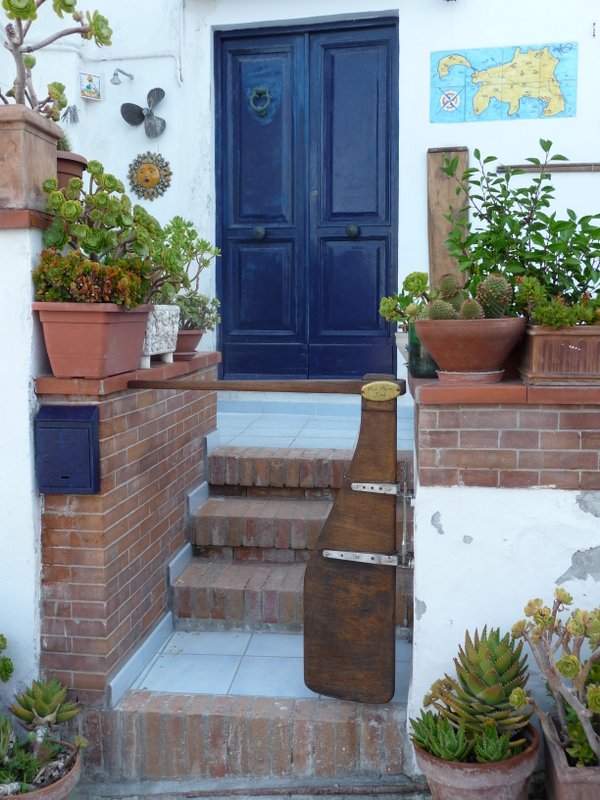
Rudder-gate
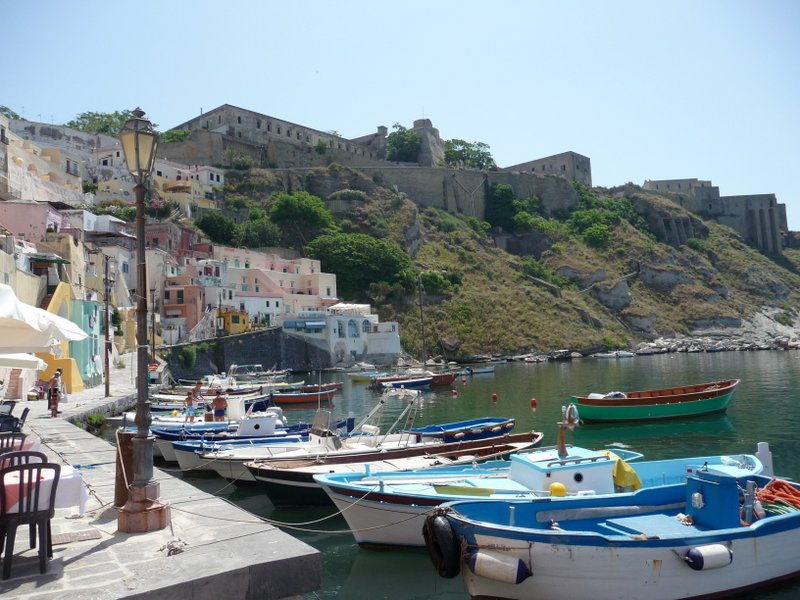
View of the castle from the quay, Procida
More light winds and calm seas meant more motoring. This time to the island of Ponza in the Pontine Islands. The Pontines are a chain of volcanic peaks jutting out of the surface of the sea. Ponza is very rugged with lots of sheer white cliffs, offshore rocks, dramatic pinnacles and sea caves. We anchored just outside of the main harbor hoping to avoid at least some of the noise and wakes from the incessant ferry and local boat traffic. We found a small and reasonably protected cove below a cemetery just east of the town of Ponza. The mausoleums on the edge of the cliff were large and ornate in typical Italian fashion, and we reckoned that the people in them are in much nicer digs than most of the living population of Italy. We hopped into the dink and explored some of the caves and crevices on the nearby shoreline. Some of the caves were clearly man-made, either for boat sheds or as part of a network of cisterns used to store and supply the island with water since ancient times. Afterwards, we enjoyed a swim in the crystal clear water.

Mausoleums and caves on the isle of Ponza
As forecast, as gale blew from the west the following day and we were in a good place to weather it. Although the winds moderated by sunset, we decided to give the seas a day to lie down before moving again. We went into the town of Ponza and had a walk around. This was high season and the waterfront, particularly near the ferry terminal was buzzing with people either starting or finishing their holiday. You could tell by the tans which were coming and which were going. We were not really sure what all the fuss was about Ponza. While the island itself is beautiful in a very stark sort of way, we found the town to be a bit lacking in character, very high priced and the local merchants seemed as if customers were merely a distraction from their afternoon nap, newspaper or mobile phone. The harbor was jammed with boats on anchor or under way, and those on board must have felt as if they were in the paint can when it was on the mixer.
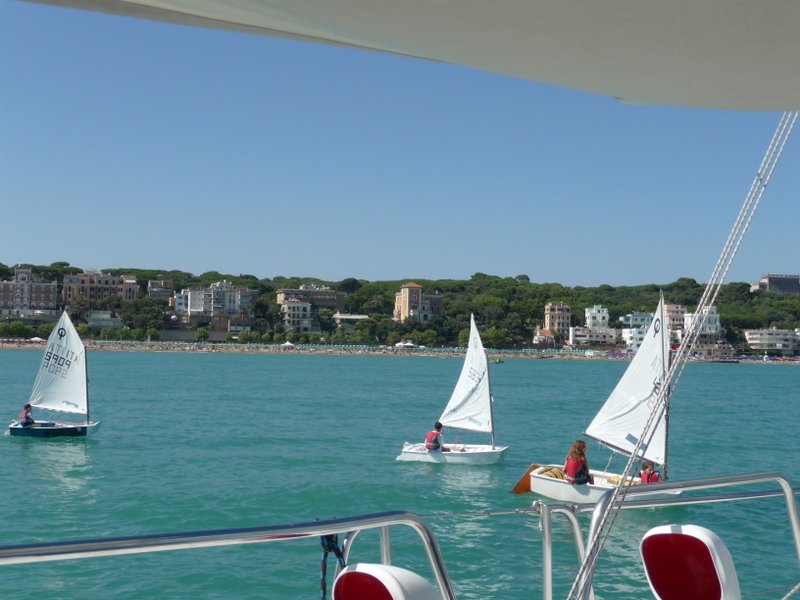
The harbor at Ponza town

A tall ship sails from Ponza. Can you name all 42 sails?
The only protected anchorage along a 100nm stretch on the mainland coast was at the town of Anzio. We made it there by mid-afternoon and saw a French yacht anchored calmly outside the harbor mole. We approached the anchorage only to find that it was a bit too shallow for comfort. The French yacht was a lovely Garcia, which has a lifting keel and rudders, and draws just one meter. The owner kindly called out to us and offered us instructions on how to get around the sand bar. We headed about a quarter of a mile away from the harbor, then shoreward, and then back to toward the harbor. Oila! We found a reasonably comfortable spot over a 4 meter sand bottom a few hundred meters off a lovely beach lined with large and impressive villas.
Anzio was buzzing with small sailing dinghies-Optimists, Lasers and a host of others. After the afternoon siesta the locals returned to their boats and we found were surrounded by sails cris-crossing the waters between Anzio and Nettuno, another marina a mile further down the coast. Merima recalled that the sailing scene was nothing like this ten years ago when she had lived in Italy. Thanks to Prada and the America’s Cup, Italians have embraced sailing in a big way.

Even the young ”Opti” sailors take an afternoon siesta at Anzio
We headed into town to have a stroll and find a pizzeria for dinner. Anzio’s town center is fairly modern, the ancient town having been bombed in WWII. If the buildings are rather uninspiring, at least the streets are very wide and accommodating of the crowds of people out shopping, heading to their favorite place to eat or simply enjoying a passegiata (evening stroll).
Early the next morning, with a good weather forecast, we made a long dash up the coast past Rome toward the beautiful Tuscan Islands.







